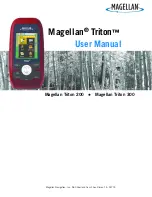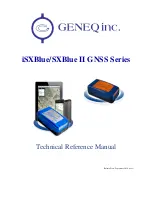
5
First, think of your iFINDER as a small but powerful computer. (But
don't worry — we made iFINDER easy to use, so you don't need to be a
computer expert to find your way!) The iFINDER includes a keypad
and a screen with menus so you can tell it what to do. The screen also
lets iFINDER show your location on a moving map, as well as point the
way to your destination.
This pocket-sized computer also contains an antenna and specialized
scanning receiver, something like your car radio. But instead of your
favorite dance tunes, this receiver tunes in to a couple of dozen GPS
satellites circling the earth. (It will also listen in to the WAAS satellites
in orbit, but more about that in the upcoming segment introducing you
to GPS and WAAS.)
iFINDER listens to signals from as many satellites as it can "see" above
the horizon, eliminates the weakest signals, then computes its location in
relation to those satellites. Once iFINDER figures its latitude and longi-
tude, it plots that position on the moving map shown on the screen. While
the screen is updated once a second, your iFINDER is making these in-
ternal calculations and determining its position several times a second!
The performance doesn't stop there. Stored in the permanent memory of
each iFINDER is a basic background map of the
entire
world. We lock it in
here at the factory — you can't change or erase this map.
Another portion of iFINDER's onboard memory is devoted to
recording
GPS navigation information, which includes waypoints, event marker
icons, trails and routes. This lets you look back the way you came.
Think of this data storage like the hard drive memory in a computer or
a tape in a cassette tape recorder. You can save several different GPS
data files, erase 'em and record new ones, over and over and over again.
Like any computer file, these
GPS Data Files
(file format *.usr) can be
shared between iFINDERs, other Lowrance GPS or sonar/GPS units,
even personal computers.
iFINDER has one more thing in common with a personal computer.
Just as computers have a floppy disk drive for storing and exchanging
files, iFINDER has a slot for an MMC (MultiMedia Card) or SD (Secure
Digital) Card flash memory card. These solid-state memory devices are
about the size of a postage stamp, but can hold data ranging from 8 MB
to 512 MB in size. (Compare that to a floppy disk's 1.44 MB capacity!)
iFINDER uses all that MMC space for two key purposes.
First, you can backup your onboard GPS Data Files by copying them to
the MMC. Since the MMC is removable (like a floppy disk or a cassette
tape), you can store these GPS Data Files on a personal computer
equipped with an MMC card reader. (Or store them on a pocketful of
Содержание Handheld Mapping GPS Receiver
Страница 1: ...Pub 988 0148 481 www lowrance com Handheld Mapping GPS Receiver Operation Instructions ...
Страница 8: ...vi Notes ...
Страница 18: ...10 Notes ...
Страница 128: ...120 Notes ...
Страница 132: ...124 Notes ...
Страница 133: ...125 Notes ...
Страница 134: ...126 Notes ...














































